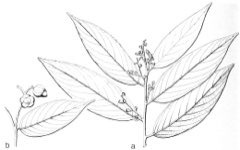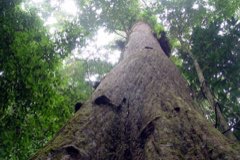 |
|
http://www.edibleplants.org |
 |
| Christoph Swoboda wikimedia.org |
Translate this page:
Summary
Neobalanocarpus heimii or commonly known as Chengal is a large tree growing about 60 m in height. It has a straight and cylindrical bole that can be branchless for 30 m or more. It is commonly found in Southeast Asia particularly in Thailand and Malaysia. Good quality resin known as 'demar penak' can be obtained from the tree. It is used in manufacturing certain classes of varnish, or as an adhesive, medicine, and fuel for torches. The wood is heavy and hard, highly durable, and resistant to wood borers, termites, and fungi. It serves many purposes in heavy construction, railways and bridges, poles, floorings, etc.
Physical Characteristics

 Neobalanocarpus heimii is a TREE growing to 40 m (131ft) by 28 m (91ft) at a medium rate.
Neobalanocarpus heimii is a TREE growing to 40 m (131ft) by 28 m (91ft) at a medium rate.
See above for USDA hardiness. It is hardy to UK zone 10. The flowers are pollinated by Bees, Insects.
Suitable for: light (sandy), medium (loamy) and heavy (clay) soils and prefers well-drained soil. Suitable pH: mildly acid, neutral and basic (mildly alkaline) soils. It cannot grow in the shade. It prefers moist soil.
UK Hardiness Map
US Hardiness Map
Synonyms
Balanocarpus accuminatus Heim Balanocarpus heimii King Balanocarpus wrayi King Pierrea penangiana He
Plant Habitats
Edible Uses
References More on Edible Uses
Medicinal Uses
Plants For A Future can not take any responsibility for any adverse effects from the use of plants. Always seek advice from a professional before using a plant medicinally.
None known
References More on Medicinal Uses
The Bookshop: Edible Plant Books
Our Latest books on Perennial Plants For Food Forests and Permaculture Gardens in paperback or digital formats.

Edible Tropical Plants
Food Forest Plants for Hotter Conditions: 250+ Plants For Tropical Food Forests & Permaculture Gardens.
More

Edible Temperate Plants
Plants for Your Food Forest: 500 Plants for Temperate Food Forests & Permaculture Gardens.
More

More Books
PFAF have eight books available in paperback and digital formats. Browse the shop for more information.
Shop Now
Other Uses
Adhesive Basketry Lighting Resin Varnish Waterproofing Wood
Other Uses A good-quality resin, known as 'damar penak', can be obtained by wounding the tree. It has been used only on a limited scale in the manufacture of certain classes of varnish[310 ]. Dammar is a hard resin, obtained from various trees of Southeast Asia. Traditionally, it is used for purposes such as caulking boats and baskets, as an adhesive, a medicine, as a fuel for torches and sometimes in foods. Dammar has many commercial applications, though many of these uses are less important nowadays due to the advent of synthetic materials. Commercially, it is an ingredient of inks, lacquers, oil paints, varnishes etc, and is used as a glazing agent in foods[891 ]. Harvesting of the resin commences when the bole is around 25cm in diameter (approx 20 years old). Triangular cuts (becoming circular with age) are arranged in vertical rows around the trunk. The cuts are several centimetres wide at first, but become enlarged at every tapping and eventually become holes of 15 - 20cm in depth and width. The average number of holes for a tree about 30 metres tall and 60 - 80cm in diameter is 9 - 11 in each of 4 - 5 vertical rows. For the higher holes, the tapper climbs the tree supported by a rattan belt and using the lower holes as footholds. The exuded resin is allowed to dry on the tree before it is collected. The frequency with which the tree is visited to refreshen the cut varies from once a week to once a month, depending on how far the tree is from the village. Tapping can continue for 30 years[891 ]. The best grades of the dammar are pale and transparent but it darkens when stored. It is a usable material for making spirit-varnish, normally with turpentine or naphtha as a solvent. The usual melting point of 90 - 100°c, and its hardness make it superior to other dammars of the same type. The defect of cloudiness in no way detracts from the utility of the varnish, which is to produce a lustrous coating[310 ]. Because collecting the dammar is fairly labour-intensive, an attempt to create a firm trade has failed[310 ] The heartwood is yellow-green when freshly cut, weathering to dark tan-brown; it is distinctly demarcated from the 2 - 5cm wide band of pale yellow sapwood which has fine yellow ripple marks visible to the naked eye. The texture is medium; the grain interlocked to straight. The wood is heavy and hard; it is very durable, being resistant to dry wood borers and termites, and very resistant to fungi. It seasons slowly, with a high risk of distortion but only a slight risk of checking; once dry it is stable in service. It has a fairly high blunting effect and so stellite-tipped and tungsten carbide tools are recommended; the presence of resin can be troublesome in machining; nailing and screwing are good, but require pre-boring; gluing is correct, but needs to be done with care due to the presence of resin. The wood is suitable for many heavy-duty purposes. It was the standard timber for durable heavy construction in Peninsular Malaysia and can be applied both indoors and outdoors. It is suitable for railway sleepers, piles, bridges, telegraph and power-line poles, vats, casks, tanks and frameworks, especially for wooden houses but even for e.g. Lorries and buses. Indoors it is used for flooring (medium and heavy duty) and joinery. It has been used in constructing wharves, ships and boats both in fresh and salt water conditions, with good results[46 , 310 , 848 ]. Despite its hardness the wood is used for carving, which is comparatively easy, especially when the wood is fresh[310 ].
Special Uses
References More on Other Uses
Cultivation details
A plant of the lowland, tropical rainforest, found naturally at elevations from sea level to 1,000 metres[303 ]. It is found in areas where the mean annual temperature is in the range 24 - 27°c and the mean annual rainfall is 2,000 - 4,000 mm[303 ]. Grows well on a wide range of soils from sandy granitic soils, red clay over shale and well-drained dark basic volcanic soils[303. Young plants need shade, and can survive in dense shade, but older plants need a sunny position[303 , 310 ]. When very young, the seedlings are sensitive to drought and overexposure to light[310 ]. Growth is comparatively slow. It is estimated that chengal will attain a diameter of 64 cm in 75 years under optimal conditions[310 ]. A tree planted in Kepong (Peninsular Malaysia) had a diameter of 48 cm after 40 years[310 ]. Chengal populations flower sporadically. Usually years with heavy flowering and fruiting occur at intervals of several years[310 ]. Flowering appears to take place over about 3 weeks and, as in most Dipterocarpaceae, the flowers are fragrant[310 ]. Pollination is by insects, most particularly honey bees[310 ]. The only method of dispersal of the heavy, wingless seeds of chengal might be by rolling down hill slopes or by means of animals[310 ]. Natural regeneration beneath parent trees is rarely abundant in virgin rain forest except on ridges in hill forest. The few seedlings usually encountered beneath a parent tree are capable of surviving for very long periods under dense shade, but light is required for further development[310 ]. Planting has been attempted in Peninsular Malaysia with indifferent results[310 ]. Insects attacked the seedlings badly[310 ]. Planting in open, unshaded conditions, in association with rubber, has failed[310 ]. Planting in secondary forest was carried out successfully[310 ]. Planted trees have been known to set fruit as early as the age of ten years[303 ].
References Carbon Farming Information and Carbon Sequestration Information
Temperature Converter
Type a value in the Celsius field to convert the value to Fahrenheit:
Fahrenheit:
The PFAF Bookshop
Plants For A Future have a number of books available in paperback and digital form. Book titles include Edible Plants, Edible Perennials, Edible Trees,Edible Shrubs, Woodland Gardening, and Temperate Food Forest Plants. Our new book is Food Forest Plants For Hotter Conditions (Tropical and Sub-Tropical).
Shop Now
Plant Propagation
Seed - it only has a short period of viability and so should be sown as soon as possible. Sown in shaded conditions, germination is usually rapid, almost without any dormancy[310 , 325 ]. Young trees need to be grown in some shade, but this needs to be reduced as they grow larger[325 ]. The fruits are best stored at about 14°C. After storing the fruits at this temperature for 50 days with a loss of 18.7% of the original moisture content and application of a fungicide, they showed no damage. Further reducing of the moisture content to just over half of that of fresh fruits did not kill them either[310 ].
Other Names
If available other names are mentioned here
Chengal
Native Plant Search
Search over 900 plants ideal for food forests and permaculture gardens. Filter to search native plants to your area. The plants selected are the plants in our book 'Plants For Your Food Forest: 500 Plants for Temperate Food Forests and Permaculture Gardens, as well as plants chosen for our forthcoming related books for Tropical/Hot Wet Climates and Mediterranean/Hot Dry Climates. Native Plant Search
Found In
Countries where the plant has been found are listed here if the information is available
Malaysia; Singapore
Weed Potential
Right plant wrong place. We are currently updating this section.
Please note that a plant may be invasive in one area but may not in your area so it’s worth checking.
Conservation Status
IUCN Red List of Threatened Plants Status : Status: Vulnerable A1cd

Growth: S = slow M = medium F = fast. Soil: L = light (sandy) M = medium H = heavy (clay). pH: A = acid N = neutral B = basic (alkaline). Shade: F = full shade S = semi-shade N = no shade. Moisture: D = dry M = Moist We = wet Wa = water.

Expert comment
Author
(King) P.S.Ashton
Botanical References
Links / References
For a list of references used on this page please go here
A special thanks to Ken Fern for some of the information used on this page.
Readers comment
| Add a comment |
|
If you have important information about this plant that may help other users please add a comment or link below. Only comments or links that are felt to be directly relevant to a plant will be included. If you think a comment/link or information contained on this page is inaccurate or misleading we would welcome your feedback at [email protected]. If you have questions about a plant please use the Forum on this website as we do not have the resources to answer questions ourselves.
* Please note: the comments by website users are not necessarily those held by PFAF and may give misleading or inaccurate information.
To leave a comment please Register or login here All comments need to be approved so will not appear immediately.
|
Subject : Neobalanocarpus heimii
|
|
|
|